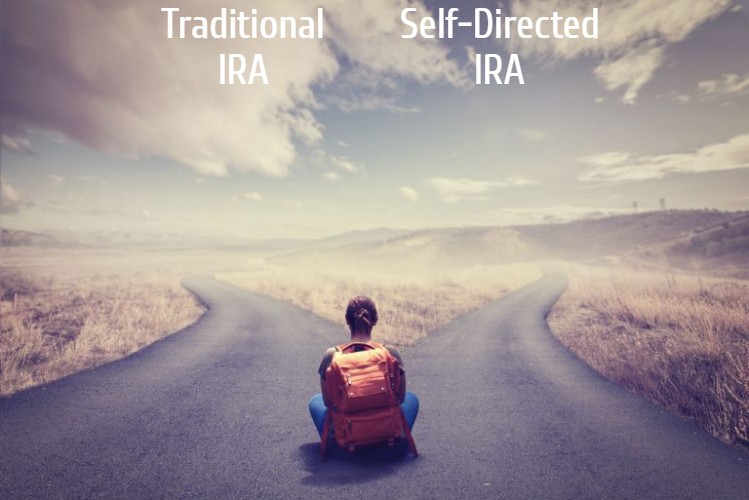There is a difference between a traditional IRA and a Self-Directed IRA, and it may be greater than you think.
An Individual Retirement Account (IRA) is a tax-deferred retirement account designed for individuals to set aside money for savings each year. Earnings will be tax-deferred until a withdrawal at age 59 1/2 or later (sometimes earlier, but a 10% penalty applies).
- A regular IRA is one that is opened at a bank or similar financial institution
- Traditional IRAs can be self-directed, with the right custodian
- A Self-Directed IRA offers more benefits and investment freedoms than a regular plan
Traditional IRA vs Self-Directed IRA
A regular IRA, oftentimes referred to as a traditional IRA, is generally overseen by a broker or investment advisor. The IRA funds are restricted to traditional investments, such as stocks, bonds and mutual funds. While Self-Directed IRAs also allow you to purchase stocks, you can also invest in hard assets, such as real estate, cryptocurrencies, gold and other precious metals, hard-money loans, and more!
Of course, “traditional” simply means it was the original IRA (as opposed to the Roth, which came along after). Basically, it refers to a pretax IRA. All contributions are made with pretax funds and no taxes are due until you withdraw from the plan. This is known as tax deferral. Like a traditional IRA, a Self-Directed IRA can also be a Roth (after-tax contributions). While both pre-tax and after-tax IRA’s have benefits, these may vary based on your individual situation. Regardless of the account type, a Self-Directed IRA allows you more control over your investments. For example, a Self-Directed IRA with Checkbook Control allows you total control over your retirement. To make an investment, you simply need to write a check. Many real estate investors use a checkbook control IRA to pay for property-related expenses or further diversify their retirement portfolio. While real estate investors is just an example, Checkbook IRA’s are quite common and allow investors the ability to make investments without needing the consent of an IRA custodian.
Although you can invest in countless assets with a Self-Directed IRA, there are some rules that need to be followed. For example, prohibited transaction rules dictate what investments are allowed in an IRA. While these rules are established by the IRS, traditional IRA’s frequently do not use them. This is primarily due to the fact that traditional IRA’s limit the types of investments you can make. Hence, being limited to stocks and bonds minimizes the need to follow specific rules.
Self-Directed IRA with Checkbook Control
In the case of a “truly” Self-Directed IRA LLC with “checkbook control”, a limited liability company (“LLC”) is established that is owned by the IRA account and managed by the account holder. The IRA Holder’s IRA funds are then transferred by the Custodian to the LLC’s bank account providing the IRA holder with a “truly” Self Directed IRA LLC.
When you establish a true Self-Directed IRA LLC, you receive complete control over your IRA funds. You no longer need each investment to be approved by the custodian of your account, as you will work with a passive custodian. A passive custodian does not approve investments or offer investment advice.
When you want to make an investment, simply write a check or wire the funds from your Self-Directed IRA LLC bank account. Ultimately, this eliminates custodian delays, which allows you to act quickly when an investment opportunity presents itself.
Establishing a Self-Directed IRA
If you are interested in establishing a Self-Directed IRA, it’s important to research the organization you wish to establish your plan. IRA Financial allows you to open an account directly through our app. We also offer checkbook control. While many traditional IRA custodians advertise that they offer Self-Directed IRAs with checkbook control, this is not the case.
A Self-Directed IRA with checkbook control allows you to invest in a world of investment opportunities, such as real estate, tax liens, precious metals, and cryptocurrencies without custodian consent. However, when you establish a Self-Directed IRA with a traditional custodian, you are unable to make any of the aforementioned investments. You can only use your retirement funds to invest in equities, mutual funds, bonds, and other investments offered by the custodian.
Learn More: Real Estate Investing with a Self-Directed IRA
Read More: Alternative IRA Investments
Get in Touch
Keep Reading
Questions to Ask Before Making a Self-Directed IRA Investment
One should consider the IRS prohibited transaction rules, the UBTI tax rules, and how best to structure the investment.
Continue Reading Questions to Ask Before Making a Self-Directed IRA Investment
Comparing Flat IRA Custodian Fees and Asset-Based Fees
When comparing flat IRA custodian fees and asset-based fees, the former almost always provides a better deal than the latter.
Continue Reading Comparing Flat IRA Custodian Fees and Asset-Based Fees
Self-Directed IRA Rules Investors Commonly Break
Self-directed IRA rules do exist, and it’s important to know these rules to keep your IRA IRS compliant. Such rules include prohibited investments and disqualified persons.
Continue Reading Self-Directed IRA Rules Investors Commonly Break
Case Study: Real Estate Investment Using a Self-Directed IRA
Here is a case study about an investor looking to invest in real estate using a Self-Directed IRA.
Continue Reading Case Study: Real Estate Investment Using a Self-Directed IRA
UBTI Rules and House Flipping with Retirement Accounts
It’s easy to flip homes or engage in a real estate transaction with a Solo 401(k) plan. It’s as easy as writing a check from your plan bank account or wiring funds. Because you are the trustee of the Solo 401(k) – also known as the Individual 401(k) or Self-Directed 401(k) plan – you have…
Continue Reading UBTI Rules and House Flipping with Retirement Accounts
Using a Self-Directed IRA for Promissory Notes
The Pocket IRA for Notes/Loans is essentially the self-directed IRA with checkbook control, allowing you to invest in alternative assets, like notes/loans.
Continue Reading Using a Self-Directed IRA for Promissory Notes

















